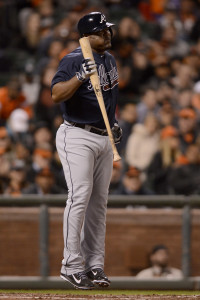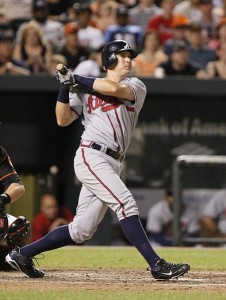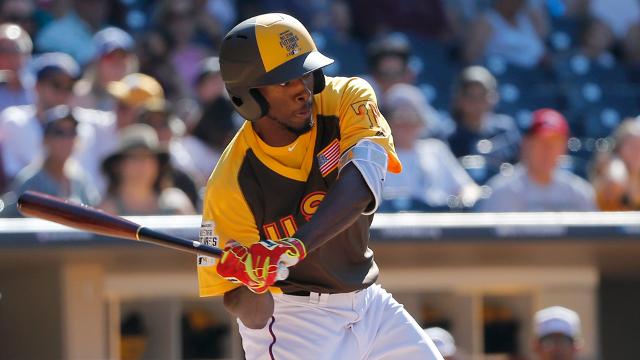On Friday, the Braves traded 3B Juan Uribe, UT Kelly Johnson, and cash to the division rival New York Mets for minor league pitchers John Gant and Rob Whalen. Here’s a closer look at the trade.
It’s little surprise that the Braves have become sellers. On the morning of the trade, Atlanta was 45-50, 6.5 games behind the Nationals with the Mets in between. They were also 6.5 games back of the Cubs for the 2nd Wild Card spot, with the Giants in that mix as well. FanGraphs’ estimated playoff odds for Atlanta that morning were 0.8%. The expectations for this team were low and they’ve met them, and with Jason Grilli done for the year and Freddie Freeman returning from a wrist injury with uncertain immediate ability, the team was unlikely to see a big turnaround. The next Braves playoff team isn’t taking the field in 2015. So, it makes sense to cut ties with those players not under contract beyond 2015, and both Uribe and Johnson fit that bill. Let’s take a close look at what the Braves gained and lost in this trade and the 4 players involved.
Juan Uribe

Well, that was a more pleasant experience than anyone expected. Acquired as essentially a cash dump from the Dodgers earlier in the season, Uribe batted .285/.353/.464 in his Braves career, posting a 127 wRC+, rating 2.9 runs above average defensively via UZR, and contributing an aggregate WAR (fWAR, bWAR, WARP) of 1.4 in less than 2 months with the team. That is All-Star production. Uribe is earning $6.5M this year, and I’m not sure what portion is still due, but it’s probably around $3.0M, as we’re a little beyond the halfway point of the season. He is a free agent at the end of the season.
What Atlanta loses: Atlanta loses a likable, productive veteran 3B who has performed like an All-Star for 2 months. There’s no question – losing Uribe will likely make the team worse. But remember – the team is already not very good.
What Atlanta gains: The ability to play Chris Johnson every day. This isn’t enticing because we’ve all been dying to see more of Chris Johnson at the hot corner. We haven’t. It’s enticing because Johnson is more realistically tradeable, if at all, with playing time than he is sulking on the bench. And trading Chris Johnson is really, really, really enticing. OFR’s Micah Smith recently wrote about how unmovable Johnson is, and I’ll direct you to his list of 5 reasons the contract is untradeable. Two of those reasons are variable: Performance and Attitude. The attitude could seemingly be better with regular playing time. The performance could reasonably improve, as his peripherals are where they’ve always been. 31.5% of his batted balls this season have been marked as Hard Hit by Baseball Info Solutions, his highest mark since 2010. He’s taking more pitches than ever before, and BABIP has always been a friend to him. That’s the thing with Johnson that we all knew – as much as we knew not to expect seasons like 2013, we knew he was fully capable of years like that, depending on some random variance. I wouldn’t expect Johnson to hit like it’s 2013 again, but he has a much better chance of doing so if he’s in the lineup regularly. If by some stroke of luck (and it would be luck), he’s able to replicate those numbers over a 2 month sample, Johnson goes from a player Micah was dreading having to release next summer to a player Atlanta could conceivable deal while picking up 50-75% of the money on the deal. You wouldn’t want this on a competitive team, but letting Johnson play regularly is an ideal path going forward for this team.
ZiPS estimated gains/losses in 2015: -0.9 WAR
Kelly Johnson

Signed in the offseason to a minor-league contract that became a 1 year, $1.5M major league deal, Johnson was for too long the sad answer to the question of who led the 2015 Braves in home runs, a fact that said more about the team than it did Johnson. His 113 wRC+ was very helpful, however, and the Braves found something of a home for him in LF, where his defense was reasonable, far more reasonable than at 3B. He played 1B near the end in Freeman’s injury-provoked absence, but that wasn’t fun for anyone involved. His versatility was a bit of an asset, in that he didn’t embarrass himself anywhere, but Braves fans shouldn’t mistake him for Martin Prado. The less defensive responsibility he has, the better. That said, he had an aggregate 0.4 WAR, which is really nice for the $800K or so the team spent on him.
What Atlanta loses: A productive bench bat, a guy who plays multiple positions without playing them particularly well, and a homegrown player who everyone was happy to have back in Atlanta. He’s a very helpful player on the roster, but was a luxury on this team.
What Atlanta gains: A roster spot for Adonis Garcia, who homered Sunday. Yeah! But seriously, not much.
John Gant
A 21st round pick in 2011, the now-22 year old Gant didn’t enter professional baseball with much velocity, throwing 85-87 mph fastballs in HS. That’s no longer the case. From John Sickels’ excellent Minor League Ball site:
While he doesn’t have an enormous ceiling of a front of the rotation arm, he’s likely to have a high floor of a bullpen piece or 5th starter with his sinking high 80’s two seamer, a four seam blend of cheese that tops out at 94 mph, a good split fingered change up in the high 70’s, and a decent hook. There’s some funk to his delivery, some would describe it as “happy feet”, but he repeats it well with solid command and a good amount of deception.
Kiley McDaniel of Fangraphs was recently impressed with his stuff, and tweeted that he had a MLB future:
Both are solid 40-45 FV guys, likely MLB contributors in a 1-2 years, could both be (upside) league avg starters or (downside) long/setup RP
— Kiley McDaniel (@kileymcd) July 25, 2015
Here’s the look he got at Gant:
Gant pitched so well in Savannah in 2014 (2.56 ERA / 3.31 FIP / 72% GB / 8.34 K9 / 2.93 BB9) the Mets aggressively sent him to AA this season, where he struggled. He was sent back to A+ ball, where he really excelled. Brought back up to AA earlier this month, he tossed 18 innings over his first 3 starts back, giving up 6 runs, striking out 17, and walking just 4.
There’s still not a ton of upside here – a ton of upside just wasn’t going to be available in a trade for Uribe and KJ – but there does seem to be a reasonably high floor. I expect to see him in the major leagues at some point or another, and that’s value enough on its own. And before we write off the upside completely, Baseball Prospectus’ PECOTA system compares him to a couple of prospects with really nice pedigrees: Andrew Heaney and Braden Shipley. While that’s likely noise in the system, it shouldn’t be wholly ignored.
What Atlanta lost: A rotation spot in Mississippi for someone else, I guess.
What Atlanta gained: 6 years of team control for a player who seems likely to play in the big leagues.
Rob Whalen
The 21-year-old Whalen has received more prospect attention, but many scouts see him similarly to Gant, as a player likely bound for the big leagues though not one likely to star there. Again, from Minor League Ball:
His bread and butter is a heavy, low 90’s, bowling ball fastball, and a potentially plus high 70’s curve with 2-7 break. Those two pitches alone could help him carve out a long career in a bullpen, but he also mixes in a potentially above average change-up and an average slider with decent command of his arsenal. He’s put an emphasis on improving his change-up this year and it shows in his splits. Whalen has a deceptive delivery he can repeat well and is looking like a viable option to start… By the time he’s ready for the bright lights and third decks, he should have three above average pitches and average command, a recipe for a #4 starter. If he can’t handle the workload, he could be a great groundball specialist in the pen capable of multiple innings.
In the offseason, McDaniel had similar things to say at FanGraphs, ranking Whalen 25th among Mets prospects:
The 6’2/200 righty sits 89-93 mph with sink and an above average curveball; the command and change-up are both just okay for now. There’s enough here to develop as a potential back-end rotation piece, but it could play up 7th/8th inning relief;
The former 12th round pick has a 3.36 ERA/3.86 FIP this year at A+ St. Lucie and has surrendered more than 3 ER just once in 14 starts. Walks have become something of a concern as the year wore on (through May, 11 walks in 46.1 innings, 23 in 36.2 innings since June 1), but this isn’t completely unusual with low minors pitchers. Still, it’s worth keeping an eye on going forward.
What Atlanta lost: A rotation spot in A+ Carolina.
What Atlanta gained: 6 years of team control for a likely future MLB pitcher.
Summary
Under John Hart, Braves fans have gotten accustomed to really nice trades. Shelby Miller and Tyrell Jenkins for Heyward/Walden. Getting Mike Foltynewicz, Rio Ruiz, and Andrew Thurman for Gattis. The swindling of the Padres (twice). The Uribe deal mentioned earlier and the inexplicable Touki Toussaint trade (from Arizona’s perspective). The majority of Atlanta fans are pleased with, nay, excited about all these trades. In this case, that didn’t happen. The Braves weren’t able to swindle Sandy Alderson into handing over an elite player. Alderson knows what he’s doing, so that wasn’t likely to happen. For all the high ceiling players they’ve been able to add over the last year, the Braves complemented them with a couple of high floor pitchers. Gant and Whalen probably won’t be great Atlanta Braves, but they probably will be Atlanta Braves. It’s safe to say that they may be more likely to reach Atlanta than someone like Toussaint. It’s nice to have both kinds of players in the organization. While Frank Wren leaned a little too heavily on these types of prospects, they do have value.
And while Uribe and Johnson have both been pleasant surprises in Atlanta in 2015, I don’t think you could argue that they’d demand a much higher price. It would have been disappointing to take too many final-year guys into September, and John Hart managed to get something useful without having too much leverage.
To me, that’s as much of a win as a Uribe-Johnson trade could have and should have yielded, assuming Arizona wasn’t involved.
The organizational growth continues, and hopefully this isn’t the last of this type of trade between now and July 31.



Future bullpen studs I think. I’m thinking Hart is going with that also. Or throw ins to acquire a bat or dump johnson in the off-season.
Thanks for reading, Matt.
I think both of these guys are more depth than impact players, but I think they will give us the depth we need to package players for a bat at some point. I figure we go after a bat in the off-season, when teams are assessing their options for the coming year.
Keep checking in, and Go Braves!
Jervis